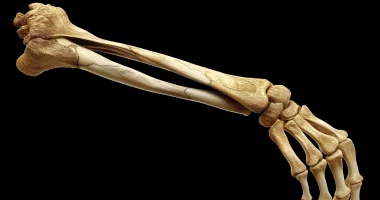Knee joint effusion
Definition
Knee joint effusion or intermittent hydrarthrosis is a chronic, constantly recurrent disease manifested by acute attacks of synovial fluid hyperproduction with joint volume increase, discomfort, and stiffness. Large joints are characteristically affected, most often the knee. Diagnosis of intermittent hydrarthrosis includes blood and synovial fluid examination, ultrasound and radiography of the joint, and histologic examination of synovial biopsy. Treatment is carried out with non-steroidal anti-inflammatory drugs; in severe cases, X-ray therapy or surgical treatment is possible.
General information
There are cases of intermittent knee joint hydrarthrosis in adults and children. However, the disease is most often diagnosed in people aged 20 to 40. Women get intermittent hydrarthrosis more often than men. Cases of intermittent hydrarthrosis in children under seven years of age have not been observed.
Causes of knee joint effusion
Modern rheumatology does not know the causes of the development of intermittent hydrarthrosis. It is assumed that the disease is associated with traumatic factors and endocrine abnormalities. In women, the appearance of intermittent hydrarthrosis is often associated with the menstrual cycle. In some cases, a hereditary predisposition to the occurrence of the disease has been traced.
Many patients with intermittent hydrarthrosis have a history of previous allergic diseases, such as urticaria, allergic dermatitis, Quincke’s edema, and others. However, the allergic or autoimmune nature of intermittent hydrarthrosis is not confirmed, as attempts to treat it with antihistamines or corticosteroids have no effect in most cases.
Symptoms of intermittent knee hydrarthrosis
Intermittent hydrarthrosis always has an acute onset with rapidly progressive changes in the joint. As a rule, only one major joint is affected. In some cases, lesions of two or more joints have been noted. A very rare phenomenon for intermittent hydrarthrosis is the involvement of two symmetrically located joints. The knee joint is the most commonly affected, but hydrarthrosis may occur in the ankle, hip, wrist, or elbow joints.
Intermittent hydrarthrosis manifests by a rapidly increasing increase in the joint’s volume, associated with the accumulation of an increasing amount of synovial fluid in its cavity. This process is accompanied by discomfort and progressive stiffness in the joint. In this case, inflammatory signs (redness and increased local temperature in the joint area) are absent. There are also no general symptoms: weakness, headache, increased body temperature, etc.
An acute attack of intermittent hydrarthrosis resolves within 3-5 days of its onset. Excess synovial fluid is resorbed from the joint, leaving no changes behind. However, intermittent hydrarthrosis attacks occur between 1 week and a month. In some patients, the interval between attacks is several months; in rare cases, attacks occur only a few times a year. Periodically exacerbated, the disease can run for an extended period, sometimes – the patient’s whole life. Each patient is characterized by a different, every time the same, period between attacks.
Diagnosis of intermittent hydrarthrosis
Intermittent hydrarthrosis can be assumed by a rather characteristic clinical picture of the disease. Patients with such symptoms should be referred to a rheumatologist for consultation. To clarify the diagnosis, clinical and biochemical blood tests, synovial fluid analysis, radiography, and ultrasound of the joint, synovial biopsy.
In clinical blood analysis in patients with intermittent hydrarthrosis, a slight acceleration of COE may be detected. As a rule, biochemical blood analysis does not reveal any pathological changes. A diagnostic puncture of the joint is performed to take synovial fluid for analysis. In this study, cytosis is observed, the content of polynucleal cells is 50% or more, and there is an increase in the number of lymphocytes and viscosity. Biopsy of the synovial membrane in intermittent hydrarthrosis reveals lymphocytic infiltration and thickening of the synovial membrane in 50% of patients.
Ultrasound of the joint during an attack of intermittent hydrarthrosis reveals expansion of the joint cavity and a significant accumulation of effusion, which are signs of chronic synovitis in the form of thickening of the synovial membrane. When radiography of the joint during the attack is observed, expansion of the articular gap increases and “blurring” shadows of periarticular tissues. There are no radiologic and ultrasound changes in the interictal period of intermittent hydrarthrosis. Several years from the onset of the disease, persistent radiologically detectable disorders appear in subchondral osteosclerosis, narrowing of the joint gap, and the appearance of marginal osteophytes.
The differential diagnosis of intermittent hydrarthrosis is made with rheumatoid arthritis, Bechterew’s disease, reactive arthritis, hydroxyapatite arthropathy, pigmented villonodular synovitis, and palindromic rheumatism.
Treatment of knee joint effusion
Therapy of intermittent hydrarthrosis is performed mainly with non-steroidal anti-inflammatory drugs (ibuprofen, diclofenac, etc.). Numerous authors note the ineffectiveness of corticosteroid therapy in the treatment of intermittent hydrarthrosis. However, the literature contains data on improvement cases against the background of weekly intra-articular hydrocortisone injections. In case of severe and frequent exacerbations of the disease with the ineffectiveness of other methods of treatment, radiation therapy may be used.
The most effective way to remove fluid in the knee joint is to perform an arthrocentesis, but this procedure does not protect against recurrences later.
In some cases, surgical treatment—synovectomy—is resorted to. However, this treatment method usually has an unstable result, and recurrences of intermittent hydrarthrosis may recur after some time.
All these treatment options are available in more than 980 hospitals worldwide (https://doctor.global/results/diseases/knee-joint-effusion). For example, Arthrocentesis can be performed in these countries for following approximate prices:
Turkey $395 in 32 clinics
China $1,117 in 9 clinics
United States $1,180 – 2,795 in 26 clinics
Germany $1,392 in 50 clinics
Israel $1,532 in 17 clinics.

